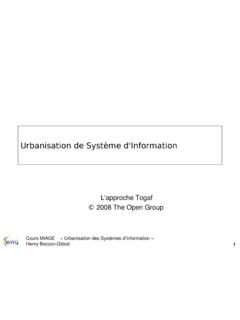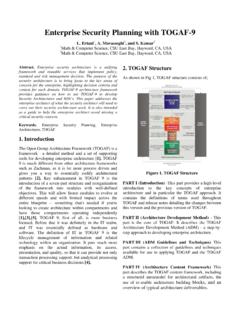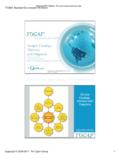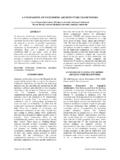Transcription of SOA Practitioners’ Guide Part 2
1 SOA Practitioners' Guide Part 2. SOA Reference architecture Painting by: Surekha Durvasula Date: 9/15/2006 SOA Practitioners' Guide Part 2: SOA Reference architecture Page 1 of 52. Contributing SOA Practitioners Surekha Durvasula, Enterprise Architect, Kohls Martin Guttmann, Principal Architect, Customer Solutions Group, Intel Corp Ashok Kumar, Manager, SOA architecture , Avis/Budget Jeffery Lamb, Enterprise Architect, Wells Fargo Tom Mitchell, Lead Technical Architect, Wells Fargo Private Client Services Burc Oral, Individual Contributor Yogish Pai, Chief Architect AquaLogic Composer, BEA Systems, Inc. Tom Sedlack, Enterprise architecture & Engineering, SunTrust Banks, Inc. Dr Harsh Sharma, Senior Information Architect, MetLife Sankar Ram Sundaresan, Chief Architect e-Business, HP-IT. Reviewers Steve Jones, CTO Application Development Transformation, Capgemini Group Prasanna Deshmukh, Director of architecture , WebEx Communications Noam Fraenkel, CTO IT, Mercury Interactive Ashok Nair, Management Systems Analyst, EAI, Information Technology Services, City of Calgary Jeff Pendelton, Executive Director, SOA Alliance Annie Shum, VP SOA Strategy, BEA.
2 Brenda Michelson, Principal Consultant and Analyst, Elemental Links, Inc. George Paolini, Consultant, The authors would like to acknowledge the many organizations and individuals that contributed portions of this document, performed substantial editing, or who provided reviews and feedback. In addition, the authors would also like to thank BEA Systems, Inc. for providing the infrastructure and the platform for developing and presenting this Guide . Date: 9/15/2006 SOA Practitioners' Guide Part 2: SOA Reference architecture Page 2 of 52. Table of Contents TABLE OF CONTENTS .. 3. 1 ABOUT THIS 5. ABSTRACT .. 5. INTENDED AUDIENCE .. 5. BENEFITS OF THE SOA PRACTITIONERS' 5. SOA PRACTITIONERS' Guide : PARTS .. 6. 2 SOA REFERENCE 7. DEFINITION .. 7. SOA REFERENCE architecture APPROACH .. 7. SOA 7. Business architecture .. 7. Infrastructure 9. Data 11. Information architecture .. 11. Architectures that Complement SOA.
3 12. ENTERPRISE SOA MATURITY MODEL .. 15. Web Application Development Stage .. 15. Develop Composite Applications .. 17. Automate Business 18. SOA REFERENCE architecture .. 19. WEB APPLICATION TIER .. 19. Packaged Applications .. 19. Custom Applications .. 21. Portal Services .. 26. Enterprise Infrastructure 27. Enterprise (Role-Based) Portal .. 28. SERVICE 29. Service Bus .. 29. Service 31. SOA 32. Service Manager .. 33. Shared Data 34. Business Process Management .. 41. SOA FRAMEWORKS .. 42. APPLICATION TIER .. 44. Legacy Applications .. 44. Mainframe Applications .. 44. Date: 9/15/2006 SOA Practitioners' Guide Part 2: SOA Reference architecture Page 3 of 52. Enterprise Application Integration .. 44. ENTERPRISE SECURITY .. 45. BUSINESS SERVICE MANAGEMENT .. 46. Typical Current State of Monitoring .. 46. Future State of Business Service 47. SERVICE ORIENTED INFRASTRUCTURE (SOI).. 48. The Business Value of Services Oriented Infrastructure (SOI).
4 51. MAPPING SOA REFERENCE architecture TO ENTERPRISE SOA MATURITY 52. Date: 9/15/2006 SOA Practitioners' Guide Part 2: SOA Reference architecture Page 4 of 52. 1 About This Document Abstract SOA is relatively new, so companies seeking to implement it cannot tap into a wealth of practical expertise. Without a common language and industry vocabulary based on shared experience, SOA may end up adding more custom logic and increased complexity to IT infrastructure, instead of delivering on its promise of intra and inter-enterprise services reuse and process interoperability. To help develop a shared language and collective body of knowledge about SOA, a group of SOA practitioners created this SOA. Practitioners' Guide series of documents. In it, these SOA experts describe and document best practices and key learnings relating to SOA, to help other companies address the challenges of SOA. The SOA. Practitioners' Guide is envisioned as a multi-part collection of publications that can act as a standard reference encyclopedia for all SOA stakeholders.
5 Intended Audience This document is intended for the following audience: Business and IT leaders, who need to start and manage an SOA strategy across the enterprise/LOB. Enterprise Architects who need to drive the vision and roadmap of the SOA program and the architecture of each implementation that falls under it Program Managers who need to manage a portfolio of sub-projects within an overall SOA. business strategy Project Team Members, who need to map dependencies and develop a timeline that meets the business expectations Vendors who provide solutions and tools for new business capabilities to the business and IT. Standards bodies which need a better understanding of use cases of how business and IT plan to leverage technology to meet their objectives. Benefits of the SOA Practitioners' Guide This document helps readers to: Learn from others: Early adopters of SOA share their best practices, insights, and views on the state of SOA adoption across the industry Compare alternatives: Identify and define the key technology components of SOA to establish a baseline reference for comparison of options Improve collaboration: A common language clarifies the nature of SOA components defined in this document Accelerate implementations: This Guide defines the services lifecycle along with the requirements, recommended tools, and best practices for each of the stages.
6 Understand the value of standards: This document recommends standards for aspects of SOA. Avoid potential risks: The Guide identifies some problem areas not yet addressed by the vendor community. Date: 9/15/2006 SOA Practitioners' Guide Part 2: SOA Reference architecture Page 5 of 52. SOA Practitioners' Guide : Parts There are three separate parts that make up the SOA Practitioners' Guide . Part 1, Why Services-Oriented architecture ? provides a high-level summary of SOA. This is Part 2: SOA Reference architecture . It provides a worked design of an enterprise-wide SOA. implementation, with detailed architecture diagrams, component descriptions, detailed requirements, design patterns, opinions about standards, patterns on regulation compliance, standards templates, and potential code assets from members. Part 3: Introduction to Services Lifecycle provides a detailed process for services management though the service lifecycle, from inception through to retirement or repurposing of the services.
7 It also contains an appendix that includes organization and governance best practices, templates, comments on key SOA. standards, and recommended links for more information. Date: 9/15/2006 SOA Practitioners' Guide Part 2: SOA Reference architecture Page 6 of 52. 2 SOA Reference architecture Definition The SOA reference architecture defines an ideal target architecture for an enterprise or LOB. Some also refer to this as the future state or future vision of the enterprise. The SOA reference architecture is key to constructing a roadmap from the current state to the target state. SOA Reference architecture Approach One needs to understand two aspects of SOA to be able to develop the reference architecture : The three SOA foundation components Enterprise SOA maturity model SOA Foundation The SOA foundation components are illustrated in the figure below. Figure 1: SOA Foundation Business architecture Business architecture describes the business strategy, objectives, priorities, and processes to be supported by the SOA.
8 An SOA is only successful if it delivers on the business architecture . Reuse of business processes provides higher ROI than the potential reuse of infrastructure or data components. Date: 9/15/2006 SOA Practitioners' Guide Part 2: SOA Reference architecture Page 7 of 52. Figure 2: Focus Areas for Business architecture Some of the best practices for developing the business architecture include: Review the current system specification and the underlying technology Map these to the business strategy to identify gaps Review the horizontal (business processes) and vertical (role-based view) requirements Prioritize the application (services) portfolio to provide these capabilities Standardize the user experience across applications Define business policies on key aspects such as application and data access and regulatory compliance Additional reference: Developing a Business architecture View (TOGAF). Date: 9/15/2006 SOA Practitioners' Guide Part 2: SOA Reference architecture Page 8 of 52.
9 Infrastructure architecture This is the engine that enables SOA. It should address all the aspects of the scalable infrastructure from networks, enterprise servers, data centers, and firewalls, to application infrastructure, security, monitoring, and middleware. The architecture team is responsible for identifying the infrastructure components the architecture building blocks required to provide the business capability. Figure 3: Example of architecture Building Blocks The above diagram is an example of the of the architecture building blocks required to provide the business capability with the primary focus being business process. At the same time, the infrastructure architecture also needs to include role-based portal requirements. Figure 4: Example of Role-Based Portal Date: 9/15/2006 SOA Practitioners' Guide Part 2: SOA Reference architecture Page 9 of 52. Infrastructure needs to combine architecture building blocks and role-based portals in order to enable: High reuse of common services Reuse of infrastructure and foundational components Reduction in time needed to develop new capabilities.
10 Infrastructure Components Description Custom application frameworks Common components required for developing Data services custom applications Logging services Exception handling Audit service Search framework Notification framework Security Security framework that could extend to the Authentication enterprise level Authorization Single-Sign-On (SSO). Delegated administration Shared data services Data services to support SOA. Master data management Data profiling Data quality service Data matching Data validation Data modeling Analytic services Portal services Portal services for consistent user interaction and Common look and feel ability to leverage WRSP. Personalization Reporting Localization Web traffic monitoring Enterprise infrastructure services Common services required enterprise wide LDAP. E-mail Collaboration (Chat/IM/Whiteboard). Content management Integrated structured and unstructured search Master data management Capabilities required to provide ability to execute Customer data integration the business processes across applications and Product master business silos Additional details on the infrastructure components are defined in the SOA reference architecture section.





